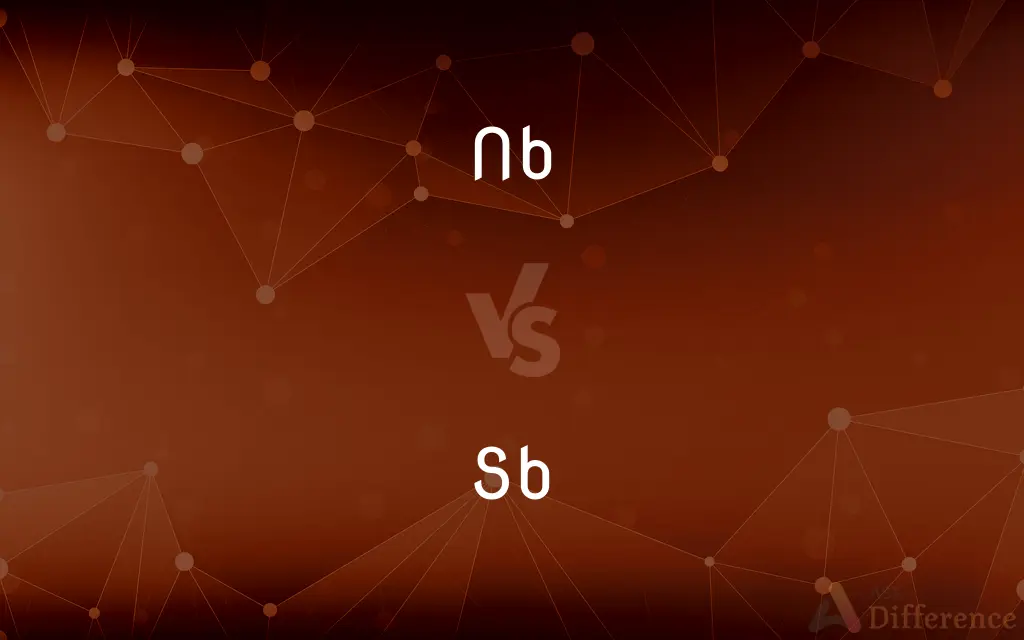Nb vs. Sb — What's the Difference?
Edited by Tayyaba Rehman — By Fiza Rafique — Updated on April 16, 2024
Nb (niobium) is a transition metal used in steel alloys and superconductors, while Sb (antimony) is a metalloid used in flame retardants and lead-acid batteries.

Difference Between Nb and Sb
Table of Contents
ADVERTISEMENT
Key Differences
Nb, or niobium, is primarily known for its use in specialty steels and superconducting materials, enhancing strength and allowing for high conductivity at low temperatures. On the other hand, Sb, known as antimony, finds extensive use in fire retardant formulations and as an alloying material in lead-acid batteries, reflecting its distinct properties and applications.
Nb is characterized by its ductility and high melting point, making it valuable in high-temperature engineering applications. In contrast, antimony is brittle and has a lower melting point, suited for applications requiring materials that melt or vaporize at moderate temperatures.
In the chemical industry, niobium is often used as a microalloying agent in steel, which improves the strength and toughness of the metal without significantly increasing its weight. Meanwhile, antimony is used in the production of antifriction alloys, such as Babbitt metal, due to its ability to enhance the hardness and mechanical strength of soft metals.
Niobium's significance in technology extends to its role in the manufacture of superconducting magnets, crucial for magnetic resonance imaging (MRI) systems. Whereas antimony compounds are used in the production of some semiconductor devices, exploiting its semi-metallic properties.
Despite its versatility in various industrial applications, niobium is less common in consumer products compared to antimony, which is often found in small amounts in products like cosmetics and plastics, enhancing their durability and performance.
ADVERTISEMENT
Comparison Chart
Category
Transition metal
Metalloid
Common Uses
Steel alloys, superconductors
Flame retardants, batteries
Physical State
Soft, ductile metal
Brittle, hard metalloid
Melting Point
High (2,468°C)
Relatively lower (630.63°C)
Electrical Conductivity
Good, improved at low temperatures
Moderate, used in semiconductors
Compare with Definitions
Nb
Nb is categorized as a transition metal with high ductility.
Nb's use in jet engines showcases its resistance to high temperatures and corrosion.
Sb
Antimony trioxide is used as a flame retardant.
Sb is added to plastics to prevent the spread of fire in electronics.
Nb
Nb is used to improve the properties of steel alloys.
Adding niobium to steel significantly enhances its strength without increasing weight.
Sb
Sb's semi-metallic properties are useful in electronics.
Antimony is used in the production of diodes and infrared detectors.
Nb
Nb is relatively inert, making it useful in chemical applications.
Niobium coatings are used to protect aerospace components from environmental damage.
Sb
Sb is classified as a metalloid.
Antimony exhibits both metallic and non-metallic properties.
Nb
Nb is considered a rare metal.
The majority of the world's niobium supply comes from Brazil.
Sb
Sb is used in lead-acid batteries.
Antimony strengthens lead plates in batteries, enhancing their longevity.
Nb
Niobium's properties make it an excellent superconductor.
NbTi alloys are essential for creating the superconducting magnets used in MRIs.
Sb
Sb compounds can be toxic.
Antimony exposure is regulated to prevent respiratory and skin problems.
Nb
(cricket) no ball
Sb
Abbreviation of somebody
Nb
Alt form|en|NB|nodot=1}}: {{init of non-binary
Sb
A metallic element having four allotropic forms; used in a wide variety of alloys; found in stibnite
Nb
A soft gray ductile metallic element used in alloys; occurs in niobite; formerly called columbium
Sb
A bachelor's degree in science
Nb
A Latin phrase (or its abbreviation) used to indicate that special attention should be paid to something;
The margins of his book were generously supplied with pencilled NBs
Common Curiosities
Can Nb and Sb be found in consumer electronics?
Nb is used in electronics primarily for capacitors and superconducting magnets, while Sb is used in semiconductors and as a flame retardant in plastic casings.
What environmental impacts do Nb and Sb have?
Nb mining and processing can lead to environmental degradation if not managed properly, whereas Sb can be toxic and poses higher risks to the environment, particularly in its mining and processing.
What roles do Nb and Sb play in battery technology?
Nb is explored for use in lithium-ion batteries due to its stability and conductivity. In contrast, Sb is used in traditional lead-acid batteries as an alloying agent to increase hardness and strength.
What are the recycling practices for Nb and Sb?
Recycling practices for Nb are less common due to its specialized uses and rarity, whereas Sb is more frequently recycled, especially from old lead-acid batteries.
What are the geological sources of Nb and Sb?
The main source of Nb is pyrochlore deposits found predominantly in Brazil and Canada. Sb is mostly sourced from stibnite ores located in China and other parts of Asia.
How are the physical properties of Nb and Sb different?
Nb is soft and ductile, making it easy to work with in manufacturing processes, while Sb is brittle and harder, limiting its ductility.
What are the safety protocols for handling Nb and Sb in industrial settings?
Handling Nb safely involves standard precautions for metals, while Sb requires stricter handling due to its toxicity, including protective gear and proper ventilation systems.
Are Nb and Sb naturally occurring elements?
Yes, both Nb and Sb are naturally occurring elements. Nb is typically found in minerals like pyrochlore, while Sb is commonly found in stibnite.
How do the mechanical properties of Nb and Sb influence their industrial applications?
The high strength and heat resistance of Nb make it ideal for aerospace and superconductors, while the hardness and brittleness of Sb are critical for its use in alloys and products requiring high dimensional stability.
How do the optical properties of Nb and Sb differ?
Nb is not typically noted for its optical properties, whereas Sb is used in infrared detectors and other optical applications due to its semiconducting features.
Are there any health risks associated with Nb and Sb?
Nb is considered relatively non-toxic, but fine niobium particles can be a respiratory irritant. Sb, on the other hand, poses significant health risks, including respiratory irritation and potential carcinogenic effects.
How does the cost of Nb compare to Sb?
Nb generally costs more than Sb due to its rarity and complex processing requirements.
How is Nb processed for use in industries?
Nb is typically processed through a series of metallurgical techniques including pyrometallurgy and hydrometallurgy to produce niobium metal and compounds.
How are Nb and Sb used in the medical field?
Nb is used in medical implants and MRI machines due to its non-reactive properties and superconductivity. Sb, while less common in direct medical applications, is used in pharmaceuticals for treating leishmaniasis and other parasitic infections.
What research and development are ongoing for Nb and Sb?
Research on Nb focuses on enhancing its properties for use in superconductors and electronic applications, while Sb research targets improving its efficiency and safety in flame retardants and semiconductors.
Share Your Discovery

Previous Comparison
Felt vs. Wool
Next Comparison
Endure vs. SustainAuthor Spotlight
Written by
Fiza RafiqueFiza Rafique is a skilled content writer at AskDifference.com, where she meticulously refines and enhances written pieces. Drawing from her vast editorial expertise, Fiza ensures clarity, accuracy, and precision in every article. Passionate about language, she continually seeks to elevate the quality of content for readers worldwide.
Edited by
Tayyaba RehmanTayyaba Rehman is a distinguished writer, currently serving as a primary contributor to askdifference.com. As a researcher in semantics and etymology, Tayyaba's passion for the complexity of languages and their distinctions has found a perfect home on the platform. Tayyaba delves into the intricacies of language, distinguishing between commonly confused words and phrases, thereby providing clarity for readers worldwide.















































